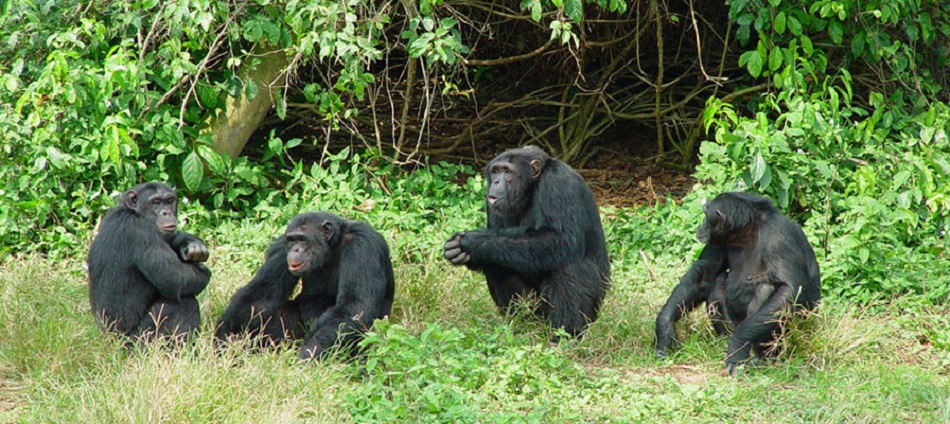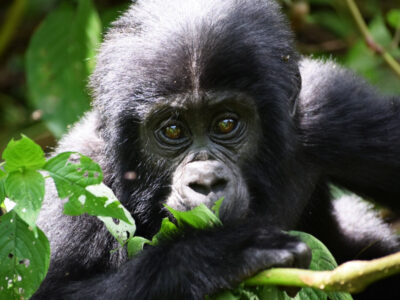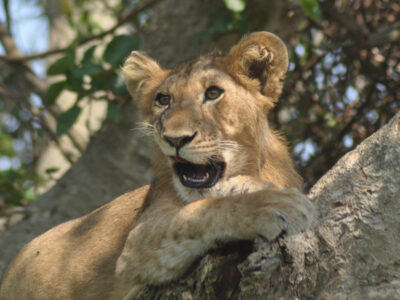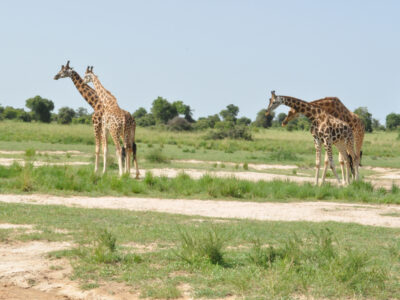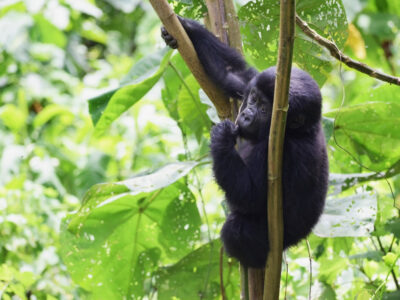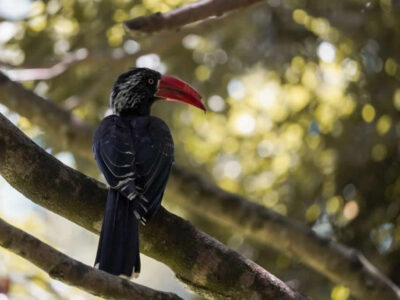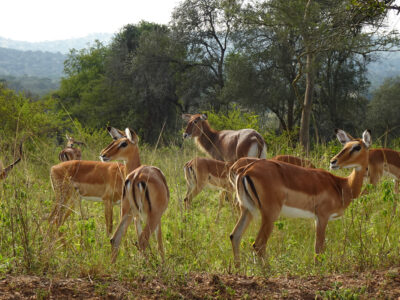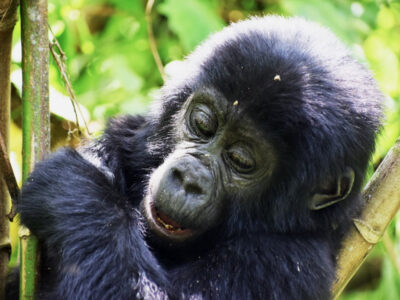The Chimpanzee is a species of primates that lives within the western rain forests. Additionally referred to as the closest living relative of humans, with whom we tend to share 98% of our DNA. Chimpanzee trekking and gorilla trekking are two of the most well-liked tourism activities in Uganda. An expert guide will accompany you on a trip into the forest in search of chimpanzees that live in groups.
Visitors undertaken chimpanzee tracking somewhere confirm that Uganda is an excellent location for both the habituation experience and chimpanzee tracking. In contrast to other parts of East Africa where chimpanzees are not domesticated, Uganda deals with various chimpanzee families both habituated and unhabituated
Chimpanzee destinations in Uganda
The best chimpanzee tracking locations are in Uganda, with about 5600 chimpanzees in the wild and a sizable number of habituated communities, it has one of the greatest populations and a range of locations where chimpanzees can be tracked. In some locations, chimpanzees in Uganda can even be seen dwelling in small forests which are owned privately. The locations listed below can be used to locate chimpanzees in Uganda.
Kibale Forest National Park
There are more than 13 different primate species to witness in Kibale forest National Park, including chimpanzees, making it the best chimpanzee tracking location in all of Uganda. Because of this, it is also referred to as the world’s primate capital. It is possible to combine chimp tracking in Kibale with birding excursions and other wildlife viewings. While tracking chimps in the jungle, it’s possible to see buffalo, elephants, antelopes, bush pigs, and other animals.
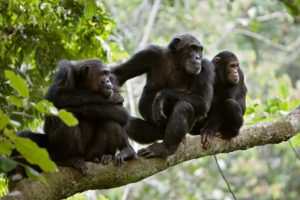
There are more than 1500 chimpanzees in total here, according to a recent census. The optimum times to go chimpanzee trekking are early in the day when the chimps are leaving their nests or in the afternoon. A maximum of one hour can be spent with the chimpanzees, and there is a greater than 90% likelihood that you will encounter them throughout your visit.
You may observe other different primate species in Kibale Forest, including black and white colobus monkeys, red-tailed monkeys, blue monkeys, Vervet monkeys, Patas monkeys, and more on the Kanyanchu primate walk, which features the largest recommendation as far as primates are considered.
Compared to other areas of Uganda, Kibale Forest permits for chimpanzee tracking cost $200. One will pay $250 for a chimpanzee habituation experience. Travelers are urged to inform their tour operators so that they can arrange chimpanzee permits for them in time to avoid disturbance at the time of trekking. Travelers can submit their bookings ahead of time for easy preparations.
Kalinzu forest
The main attraction for tourists within Kalinzu forest is chimpanzee trekking. One of Uganda’s largest chimpanzee communities can be found in Kalinzu Central Forest Reserve. as compared to Kibale Forest in Uganda, it is probably the second-best location to go looking for chimpanzees. Nearly 50 of the 320 chimpanzees in the forest reserve have been acclimated (ready to be tracked). Even though Queen Elizabeth National Park has its chimpanzee group at Kyambura Gorge, the majority of visitors prefer tracking chimpanzees in Kalinzu woodland.
Kalinzu Forest is a tropical rainforest that is rich in biodiversity and bustling with life. Chimpanzees, baboons, blue monkeys, red-tailed monkeys, L’Hoest’s monkeys, vervet monkeys, and black-and-white Colobus monkeys are among the six species of primates. The location is Queen Elizabeth Park’s top chimpanzee attraction. Chimpanzee sightings are more likely to occur in Kalinzu Forest than in Queen Elizabeth Park’s Kyambura Gorge.
Kyambura Gorge, Queen Elizabeth NP.
While Queen Elizabeth National Park is famous for its savannah wildlife, the Kyambura Gorge hosts a thick forest that is home to chimpanzees and other small primates like red-tailed monkeys, colobus monkeys, baboons and. This means that your trip to Queen Elizabeth National park can include looking for these great apes.
Although the chimpanzee population in this area is moderate, Kyambura Gorge offers certain benefits for chimp trekking. It is one of the locations where animals congregate to drink, providing an opportunity to see other small primates and Africa’s mammals. It is situated within Uganda’s most popular national park. A traveler who goes chimpanzee tracking at Kyambura Gorge has a unique chance to go on a full tour that combines chimpanzee trekking, birding, and a wildlife drive to Queen Elizabeth National Park.
The chances of seeing chimps in Kyambura Gorge are not as high as in Kibale national park and this is due to the limited numbers and different local ecosystems. Your tracking usually takes between 1 and 3 hours depending on the location and movement of chimps on your day of visiting them. You can decide to track either in the morning hours at 8:00 AM or at 2:00 PM.
Budongo forest
The Budongo Central Forest Reserve is another place tourists can get to see the chimpanzees in Uganda. It is located near Masindi town towards Murchison Falls National park.
The forest has trails crisscrossing to ease access for researchers and eco-tourists who frequent here. The chimpanzee tracking here also starts at 8:00 AM and 2:00 PM with an 80% chance of seeing the chimps.
Ngamba Island Sanctuary
The Ngamba island chimpanzee sanctuary was established as an initiative to safeguard and preserve the orphaned chimpanzees that are discovered abandoned in the jungle without any family to assist them. The sanctuary is situated on Ngamba island, which is part of Uganda’s Sese Islands in Lake Victoria.
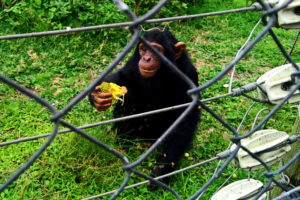
It was founded in 1998 and had 19 chimpanzees at first, but because of the work done to save these animals, it now has more than 25 chimps. Due to a lack of area to support such large numbers, chimpanzee reproduction is prohibited. The sanctuary implanted contraceptive methods in female chimpanzees to prevent conception, however, the technology is not completely reliable because some newborn chimpanzees have been born despite the females’ attempts to avoid conception.
Unlike other chimpanzee attractions in Uganda, the sanctuary is available to visitors and provides a wider range of activities and opportunities to interact with the primates. Visitors to the Ngamba island sanctuary who go chimpanzee tracking have the chance to participate in all four feeding supplemental programs and take part in their daily routines like feeding, shoring, regular tests, and preparing their sleeping facilities through a caregiver initiative at the sanctuary.
Toro-Semuliki Wildlife Reserve
Tourists can also enjoy Chimpanzee tracking at Uganda’s oldest wildlife reserve. The Semuliki reserve also has a diversity of wildlife, which includes forest mammals and a variety of birdlife.
The Mugiri forest river in Semuliki is remarkably rich in primates especially chimpanzees with over 70 individuals. Guided nature walks around Ntoroko are also available.
The Toro-Semuliki Wildlife Reserve can be visited along with the neighboring Semuliki National Park which is popular for birding, hot springs, and unique natural flora that is a blend of Eastern and Central Africa.
Chimpanzee trekking rules and regulations
To have a positive chimp trekking experience, you must adhere to certain laws and regulations. To safeguard both the visitors and the primates, these were put in place by the Uganda Wildlife Authority. These regulations were put in place to safeguard the chimpanzees, who are at risk of extinction, and trackers are the most important thing to observe when in their natural habitat. Because of this, chimpanzees go through a 2- to 3-year training procedure to become accustomed to people and not run away during the visit.
- You are not allowed to trek in case of any illness or sickness, especially with flu and cough, this is because chimpanzees are the closest cousins of humans for 98% of human DNA.
- You are to keep a distance of 8 meters between you and the chimps
- You should always follow all the guidelines that are given to you by the tour guides
- When you encounter the chimpanzee, you are not allowed to feed them.
- Visitors are not allowed to eat or drink near the chimpanzees.
- Avoid going potty and urinating in the park because doing so could make the animals sick. To poop, you must first create a hole that is about 30 cm deep and then covers everything—including the toilet paper—in it.
- The minimum age for chimp trekking in Uganda is 15 years.
- Make sure that the camera you are using does not have a flashlight to scare them away
- Do not make noise while trekking because this irritates the chimps and they end up migrating to another place.
Chimpanzee Tracking Permits & Costs
For conservation reasons, there is a limit on the number of people who can visit chimpanzees in their wild environment. This is an effort to make sure that tourists don’t interfere with their natural lives. For this reason, for you to track chimpanzees you need to purchase a permit that allows you entry for a specific day of chimp tracking in any of the protected areas.
Chimpanzee Tracking is a worthy adventure tour experience for any visitor to Uganda. It is advisable to book the permit months before your tour to allow ease of planning. If you are traveling with us, we’ll purchase the chimp permits on your behalf ahead of time – to make sure all preparations are done before the safari starts.
In the Kibale Forest National Park, the chimpanzee trekking permit costs $200 and $250 for habituation; in the Budongo Forest, it costs $90; in the Kalinzu Forest, it costs $50; and in the Kyambura Gorge, it costs $50.
Additionally, permits to places like Kibale National Park are limited when its peak season since only a limited number of visitors can see the chimps every day.
Best time for Chimpanzee Tracking in Uganda
Uganda lies along the Equator and is always warm. The only difference in seasons is usually in the amount of rainfall and how often it rains in a certain period.
Because you will be visiting tropical rainforests to these wild chimps, you should expect some rain at any time of the year. We advise that you visit during the dry season months when the chances of rain are low and the rain will be a slight pour.
The best months to visit Uganda for chimpanzee tracking are the dry season months of January, February, and between June, and August. The dry season months make it a bit easier for you to move around in the thick forests.
Other months of March, October, and December include a little rain but you can still get to enjoy chimp tracking at any of the places around Uganda. for the best chimpanzee tours in Uganda, you should look out for our 5 days primate safari or 3 days safari to Kibale forest national park and the longer tour of 8 days primate and wildlife safari to enjoy the best experience with the chimpanzees in the jungle.

